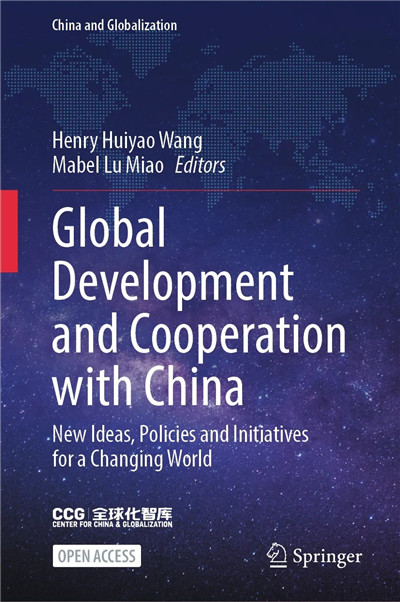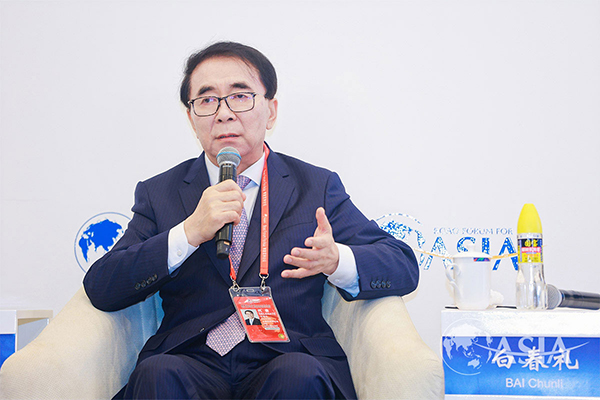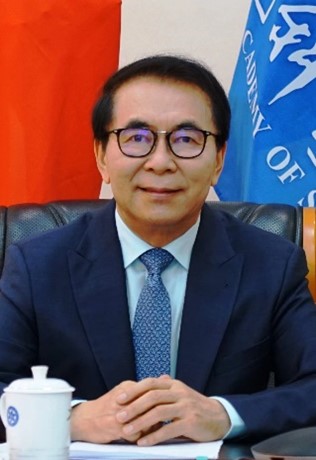Bai Chunli: The Role of Mega-science Facilities
October 28 , 2025By Bai Chunli
President of the Alliance of International Science Organizations (ANSO)
Today, new revolutions in science, technology, and industrial transformation are happening at an increasingly rapid pace, while innovations in new areas hail the start of an era of “big” science and “big” convergence through the use of mega- science facilities, which have great potential to enhance our ability to explore the mysteries of nature and make breakthroughs in key core technologies. China’s mega-science facilities and scientists are working with the world for scientific advancement and the in?nite benefits that can be achieved through cooperation and resource sharing to realize the full potential of these facilities and the scientists that use them.
Today, a new round of revolution in science and technology and industrial transformation is in the making at increasingly rapid pace, while science and technological innovations continue to delve deeper and broader into new areas that have enabled us to enter an era of “big” science, “big” convergence, and increased integration. Inter-disciplinary scientific exchanged has increased, technologies have become more integrated, scientific breakthroughs achieved through group efforts have increased, and scientific innovation is becoming increasingly more complex.
Meanwhile, major scientific discoveries and innovations now depend more and more on “mega-science facilities” and the support that they provide. Mega-science facilities providetheperfectconditionsfor exploringtheunknown world,discovering thelaws ofnatureandachievingrealtechnologicalbreakthroughs. They have become thematerialandtechnologicalfoundationsforpushingthefrontiersofscienceandfor solving major challenges in socioeconomic development and safeguarding national security. “Mega-science facilities” have clear research objectives and a broad range of applications, but require a huge amount of investment and advanced cutting-edge technologies. However, these unique characteristics make them more likely to become leaders in major scientific discoveries and play a major leading role in the advances of academic disciplines. The R&D that has been done to develop these facilitieshasintegrated many newscientificprinciplesandcutting-edgetechnologies, giving us a great potential to not only enhance our ability to explore the mysteries of natureand effectively drive inter-disciplinaryresearchprojects, but also establishkey platforms and methods to promote high-tech development and make breakthroughs in key core technologies.
In this paper, I would like to focus on three major aspects of how these facilities can benefit the exploration of the frontiers of science. I will start with the role of “mega-science facilities”, including an introduction to their origins and development. Next, I will provide an overview of the current state of these facilities in the world and their unique contributions. Finally, I will present China’s commitment to ensuring that these facilities are open and foster a culture of sharing and cooperation.
The Role of Mega-science Facilities
R&D into mega-science facilities started 80 years ago in the United States during World War II. At the time, the United States invested heavily in the Manhattan Project and developed a series of nuclear reactors and accelerators to strengthen and support US research into nuclear energy, nuclear physics, and particle physics. After WWII, the United States, the Soviet Union, and other leaders in science and technology started to implement various large-scale research initiatives including artificial satellite programs, manned space programs, and the historic Apollo program that placed the first human on the moon. These programs were largely developed in “mega-science facilities” that were located around the United States.
Since the 1950s, the role of these large-scale facilities has become increasingly central. The unique research conditions that these facilities provide have resulted in a large number of original scientific breakthroughs and key technological innovations. Mega-science facilities are powerful tools in exploring new heights in science and technology, while research increasingly relies on these facilities to make major discoveries. Over the last 100 years, of the Nobel Prizes awarded for Physics, twenty have been given due to the support of mega-science facilities. Prior to 1950, only one prize had been awarded to someone doing work at a mega-science facility, but after 1970 more than 40% were given to individuals that received support from these facilities, which provided tools like astronomical telescopes, scientific satellites, and particle accelerators just to name a few. Since 1990, this percentage has increased even further to as high as 48%. In the last 20 years, in the field of protein macro- molecular structures alone, a Nobel Prize has been awarded every three years thanks to the access to synchrotr on radiation facilities.
Looking into the future, major discoveries and innovative breakthroughs will rely increasingly on the support of these “mega-science facilities” . Einstein pointed out that the future of science is nothing more than a continuous exploration into the macroscopic and microscopic worlds, which these facilities have facilitated and are becoming increasingly central to the expansion of scientific research and exploration. This is what I would like to explore further now.
In China, many sum up the frontiers of science in the macro-world in terms of “Two Darks, One Black and Three Origins” . “Two darks” refers to dark matter and dark energy, “one black” refers to black holes, while the “three origins” stand for the origin of the universe, the origin of celestial bodies, and the origin of life. A major breakthrough in any of these areas will significantly enhance our understanding of the universe and may even trigger a revolution in the field of physics.
For example, in April 2019, after two years of observation and analysis of a massive amount of data, the Event Horizon Telescope, composed of eight submillimeter radio telescopes distributed around the world, released the first-ever image of a super-black hole located 55 million light-years away from Earth and a mass of 6.5 billion times of that of the sun, and did it simultaneously via live broadcast. This is the first time that humans ever saw the “face” of a black hole and it attracted global attention. In December 2021, NASA launched the James Webb Space Telescope, which is tasked with four important missions: to find the earliest galaxies in the universe; to study how galaxies evolve; to observe the formation of stars and planets; to measure the physical and chemical properties of planets, including those in our solar system; and to explore the possibility of life in other planetary systems. These findings will help scientists find clues and, ultimately, answers to some of the most elusive questions like the origin of the universe and whether extraterrestrial civilizations exist.
Exploring the nature and rules of movement of the material world and life at the microscopic level is another major part of pushing the frontiers of science. For example, in the field of particle physics, scientists once put forward a standard model describing three kinds of basic force (strong force, weak force, and electromagnetic force) and the basic particles that compose all matter, identifying a total of 61 elementary particles. It was facilities like the Large Hadron Collider (LHC) that made it possible to find and study these elementary particles. The LHC is the world’s largest and most powerful particle physics accelerator. In 2013, scientists used it to detect the Higgs boson and verified the last remaining elements of the Standard Particle Model,enabling the team to identify all 61 elementary particles that were predicted by the model.
After the discovery of the Higgs boson, the exploration of new topics in physics beyond the Standard Particle Model has become a central focus of the physics community today. In 2015, China Academy of Sciences scientists, in collaboration with scientists from other countries, discovered a new neutrino oscillation mode using the Dayawan Nuclear Reactor Neutrino Experiment in Guangdong, which is considered one of the most important breakthroughs in the field in recent years. While the Dayawan Nuclear Reactor facility has completed its scientific goals and been retired, other neutrino physics-related work is still progressing at the Jiangmen Underground Neutrino Observatory in China, the Deep Underground Neutrino Experiment (DUNE) in the United States, and the Super-Kamiokande Neutrino Detection Experiment in Japan. Of these three, the Jiangmen Underground Neutrino Observatory is addressing one of the key questions in international neutrino research—neutrino mass ordering.
In the area of quantum control, quantum communication and quantum computation are key areas of research and face intense competition. So far, China has taken the lead in this field. In 2016, the Chinese Academy of Sciences successfully launched the world’s first quantum science satellite, Micius. Within a year after the launch, three key milestones including satellite-to-ground quantum key distribution, satellite-based entanglement distribution to two locations on the Earth, and ground-to-satellite quantum teleportation had been achieved. In 2017, I personally experienced intercontinental secure communication in a phone call with TWAS Fellow Anton Zeilinger, the President of the Austrian Academy of Sciences and recipient of the Nobel Prize in Physics in 2022, which was made possible by the Micius satellite. These achievements have laid the foundation for the construction of a global quantum communication network, which has already been realized in the Beijing-Shanghai network, the world’s first large-scale space-ground integrated quantum communication network.
Today, many countries in the world attach great importance to the research into cutting-edge, fundamental issues. However, many of these issues are either too big (heavenly movement, evolution of the galaxy, and the origin of the universe) or too small (particle structure and quantum control) and require access to and support from these “mega-science facilities”. To this end, many developed countries and even some emerging economies have increased investment in key “mega-science facilities” with the hope of taking the high ground in the future development of science and technology. We believe that these kinds of facilities will be central to future exploration of the endless stretches of the universe as well as the boundless depths of the microscopic world.
Major Mega-science Facilities and Their Contributions
Countries around the world are actively developing “mega-science facilities” to push the boundaries of scientific research. The development and purpose of mega-science facilities are very different from that of rank-and-file facilities in terms of the equipment they contain and even how they are built. Some of the unique characteristics of these facilities include:
• broader and farther-reaching impact on developments in science and technology;
• bigger in terms of scale, requiring more resources and more time to construct and operate;
• more comprehensive and sophisticated technologies, requiring a large number of non-standard equipment and parts that present challenges in both engineering and R&D;
• greater focus on scientific knowledge and technology innovation, not commercial application;
• greater latitude required in terms of project approval and R&D, as well as greater international cooperation.
For a long time, major developed countries, such as the United States and European countries and Japan, have attached great importance to R&D into mega-science facilities and have considered them a part of their core competitiveness in science and technology. They have tried to maintain this competitive edge by increasing investment and strengthening related R&D and strategic planning.
The United States, for example, has created a large number of mega-science facilities for use in high performance in fields, such as high-energy physics, nuclear physics,astronomy, energy, nanotechnology, eco-environment, and information technology, which are mainly funded and managed through the Department of Energy and the National Science Foundation. According to statistics, there are about 60 such facilities that have been central to a number of major scientific discoveries and have made a number of major technological breakthroughs and thus played a key role in strengthening scientific and technological innovation, enhancing national security and driving the socioeconomic development of the United States.
In Europe, mainly represented by the UK, France, and Germany, a large number of mega-science facilities have been created in the fields of energy, life sciences, resources and the environment, space science, particle physics and nuclear physics, as well as engineering and technology. In order to integrate resources and enhance overall competitiveness in science and technology, EU countries have jointly developed andconstructed a largenumberofworld-leading mega-sciencefacilities.Major scientificachievementsandinnovationsmadebythesefacilitiesincludethediscovery of the Higgs boson and the invention of the World Wide Web, which laid the foundation for the Internet economy. These facilities have not only helped Europe maintain its competitive edge in science and technology, and they have also contributedto peaceful cooperation between EU members while at the same time expanding Europe’s footprint in the global technology market and a major role in the global industrial chain.
The above is a list of mega-science facilities in the world’s major countries (Table 1).
The Chinese government attaches great importance to the development of mega- science facilities and strongly supports the participation and initiation of international mega-science programs. After decades of investment and development, China has created a strong infrastructural base and formed a number of national centers for innovation and talent development linked to mega-science facilities.
So far, China has approved 57 major mega-science facility projects, 32 of which are already in operation and 25 of which are under construction. Some these facilities are on par with the best centers for research and innovation in the world. The Chinese Academy of Sciences (CAS) is a pioneer China’s basic R&D infrastructure and contributed to the development of mega-science facilities. Generations of scientists and engineers at CAS have made noteworthy contributions to the construction and operation of over 30 of these facilities, or more than 50% of China’s total. CAS has also carried out extensive cooperation with research institutions and universities around the world in the research and development of facilities, which are open to institutions and researchers from both China and abroad to explore the frontiers of science.
China’s mega-science facilities have enabled Chinese scientists to make a number of major scientific achievements and technological breakthroughs. These include:
• “Wukong”, a satellite officially known as the Dark Matter Particle Explorer (DAMPE) developed and launched by CAS in 2015, which aims to find dark matter particles. Since it was put into service seven years ago, it has made four outstanding scientific achievements: direct detection of a break in the cosmic electron plus positron energy spectrum at an energy level of 0.9 TeV; the precise measurement of the energy spectra of the proton and helium components of cosmic rays, revealing new spectral features that are helpful in understanding the origin of cosmic rays; the precise measurement of the spectra of cosmic ray boron-to-carbon and boron-to-oxygen ratios, revealing spectral breaks of such ratios which are essential in understanding the propagation of cosmic rays; and the release of all-sky gamma-ray data to the public and obtaining the most sensitive constraints on dark matter models to produce gamma-ray lines.
• The Large High Altitude Air Shower Observatory (LHAASO), developed and built by CAS, has found a dozen ultra-high-energy (UHE) cosmic accelerators within the Milky Way. It has also detected photons with energies exceeding 1 Peta-electron-volt (quadrillion electron-volts or PeV), including one at 1.4 PeV, the highest energy photon ever observed. These findings overturn our traditional understanding of the Milky Way and open up an era of UHE gamma astronomy. This discovery has laid the foundation to solve a century-old mystery—the“origin of cosmic rays and their acceleration” .
• In the field of fast radio bursts (FRBs), a new frontier of astrophysics, the Hard X-ray Modulation Telescope localized the X-ray counterpart of the first Galactic FRB; the Five-hundred-meter Aperture Spherical radio Telescope (FAST), also known as the “China Sky Eye”, has produced a number of top-level achievements in the last two years, including capturing the largest radio burst in history, which was voted into the top 10 Scientific Achievements of China in 2021.
• The Experimental Advanced Superconducting Tokamak (EAST), also called the “China’s artificial sun”, achieved a repeatable plasma discharge at a temperature of 120 million degrees Celsius with a pulse length of 101 s, once again setting a new world record for tokamak operation. These achievements signal China’s leading position in the research field of steady-state magnetically confined fusion.
China has actively participated in or initiated multiple mega-science programs in other countries. In March 2019, seven founding countries, including China, signed a cooperative agreement on the development of the SKA (Square Kilometer Array). So far, the design phase of the SKA has been completed, and the first phase of construction is underway. Once completed, the SKA will have a total collection area of one square kilometer composed of about 2500 dishes spread out over Southern Africa, and 1 million antennas in Australia. It will be the largest astronomical facility that has ever been built and will mark the beginning of a new era in our understanding of the universe. Phase 1 of the SKA is expected to be completed and in full operation before 2030.
Chinese scientists have also been actively involved in the International Thermonuclear Experimental Reactor (ITER) project. ITER is one of the largest multilateral collaborative projects second only to the International Space Station. The goal of ITER is to test and validate the scientificness and engineering feasibility of the peaceful use of nuclear fusion for the generation of electricity. ITER aims to fundamentally solve the energy, environment, and sustainable development challenges facing mankind. It involves over 30 countries including China, the EU, Russia, the US, Japan, South Korea, and India. Thanks in part to the achievements at the Tokamak facility mentioned above, Chinese companies won the tender for the Tokamak Assembly Contract 1 (TAC1) and will be the chief contractor of the project. This is the largest contract in monetary terms since the initiation of the project. In 2017, international experts in nuclear fusion jointly issued the “Beijing Fusion Declaration—Supporting Fusion Energy Development in China”, supporting the construction of the China Fusion Engineering Test Reactor (CFETR).
A distinctive feature of mega-science facilities is openness and sharing. The Chinese government attaches great importance to this and has actively promoted the opening up and sharing of its mega-science facilities to the world. On December 2–4, 2019, the 14th meeting of the Group of Senior Officials on Global Research Infrastructures (GSO 14) was held in Shanghai, the first GSO meeting ever held in Asia. At the meeting, Chinese representatives presented the development of mega-science research facilities in China and international cooperation that has been achieved through these facilities, suggesting Chinese mega-science facilities be included in the GSO system as case studies to further strengthen the sharing and cooperation. So far, there are some successful cooperation models with international research institutions. On March 31, 2021, FAST officially opened for international cooperation, calling for research proposals from astronomers around the world. It received applications for a total of 7216 h of observation time submitted from scientists around the world, and 27 of which from 14 countries excluding China were approved.
China also works to help other developing countries build and operate their own mega-science facilities. One example is the new Siam Photon Source (SPS-II), which, once completed, will be operated by the Synchrotron Light Research Institute (SLRI) in Thailand. This will be the first fourth-generation synchrotron radiation facility in Southeast Asia and will receive technical support from the Shanghai Synchrotron Radiation Facility (SSRF) and Shanghai Advanced Research Institute SARI) of the Chinese Academy of Sciences. Another example is the Thailand Tokamak (TT-1), and the main engine and the auxiliary systems for which were donated to Thailand by the Institute of Plasma Physics (ASIPP) of the Chinese Academy of Sciences. Once completed, it will be the first tokamak in Southeast Asia. ASIPP will assist the Thailand Institute of Nuclear Technology (TINT) in the areas of personnel training, cryogenic technology, power supply management, installation, and operation and will help Thailand build a new generation of tokamak in the future.
As Chinese President Xi Jinping has emphasized many times, China’s open door will never close and can only open wider. China’s mega-science facilities and Chinese scientists are determined to expand cooperation with institutions and individuals around the world for the common goal of scientific advancement. The benefits that these facilities can create for mankind are infinite, and it is only by working together and sharing these resources that we can realize their full potential. Achievements that have been made so far have advanced our knowledge of the universe and our own world considerably, and it is our belief that as the world reconnects more fully post-pandemic, cooperation and exchange will grow exponentially.
About ANSO
The Alliance of International Science Organizations (ANSO) is a non-profit, non- governmental organization founded in 2018 by 37 national academies, research institutions, universities, and international organizations from around the world in the coordination with the Chinese Academy of Sciences (CAS) with 67 members from 48 countries. ANSO’s goal is to promote shared development and advance the UN Sustainable Development Goals by fostering multiple international programs in Science, Technology, Innovation, and Capacity-building (STIC).
Chunli Bai is President of the Alliance of International Science Organizations (ANSO). A chemist and expert in nanoscience, he is also former President of the Chinese Academy of Sciences (CAS), former President of The World Academy of Sciences (TWAS), and Honorary President of the University of Science and Technology of China (USTC) and the University of Chinese Academy of Sciences (UCAS). His research focuses include organic molecular crystal structure, EXAFS, molecular nanostructure, and scanning tunneling microscopy. He is a member of many prestigious academies including CAS, TWAS, the National Academy of Sciences, the Royal Society the European Academy of Sciences, and the Russian Academy of Sciences.
Editor’s Note
This essay is selected from the book Global Development and Cooperation with China: New Ideas, Policies and Initiatives for a Changing World, which is the ninth volume of the “China and Globalization Series” books. This book series seek to create a balanced global perspective by gathering the views of highly influential policy scholars, practitioners, and opinion leaders from China and around the world. The open access book Global Development and Cooperation with China combines the insights and wisdom of 26 representatives from a wide range of international organizations into a collection of 21 essays, focusing on the latest trends in four major areas—global governance, trade and economics, science and technology, and culture and exchange—providing the reader with information on the latest developments in these areas with a special focus on China and its relevant contributions.

Editors: Henry Huiyao Wang, Mabel Lu Miao
ISBN: 978-981-96-2452-2
Published in April, 2025
Publisher: Springer Nature
Download at Springer Nature:
Topical News See more









